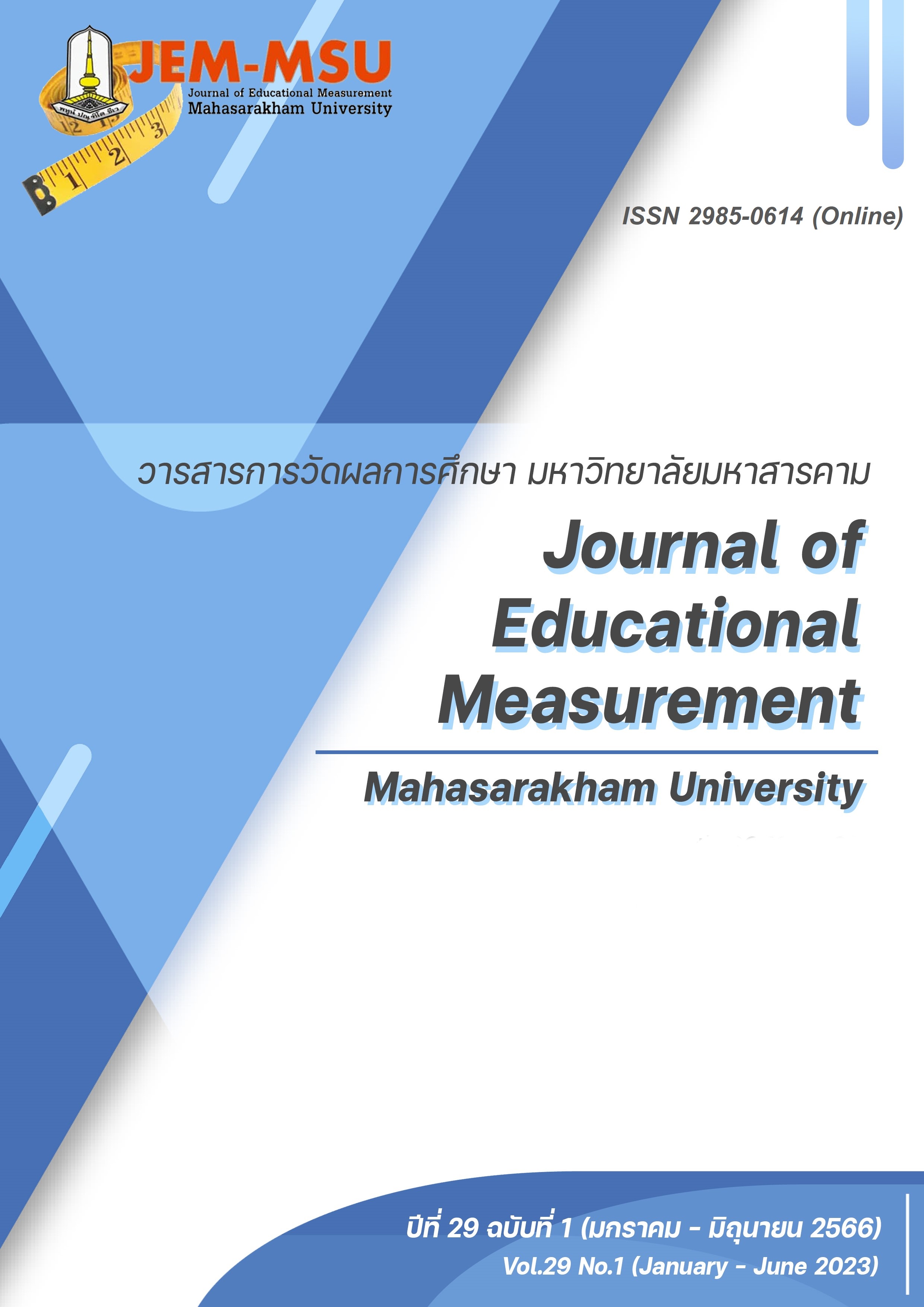A Comparison of the Item Information Function of the Mixed-Format Test for Mathematical Literacy with Different Test Lengths and Proportions of Items
Main Article Content
Abstract
The objectives of this research were to 1) construct mixed format of mathematical literacy tests with different test lengths and proportions of items, and 2) compare the item information function of the mixed-format tests for mathematical literacy with different test lengths and proportions of items. The sample consisted of 900 grade 9 students. The research instruments were mixed-format tests for mathematical literacy with different test lengths and proportions of items. These tests consisted of the following models: (1) Model 1, with the length of thirty items and the proportion of multiple-choice items and subjective items of 30:70 percent; (2) Model 2, with the length of thirty items and the proportion of multiple-choice items and subjective items of 50:50 percent; (3) Model 3, with the length of fifty items and the proportion of multiple-choice items and subjective items of 30:70 percent; and (4) Model 4, with the length of fifty items and the proportion of multiple-choice items and subjective items of 50:50 percent. The statistics used in the data analysis were frequency, percentage, mean, standard deviation and one-way ANOVA. The findings were as follows:
1.In the construction of the mixed-format tests, 4 different test lengths and proportions of items were obtained. Model 1 and Model 2, each with the length of 30 items, had the reliability of 0.842 and 0.803 respectively. Model 3 and Model 4, each with the length of 50 items, had the reliability of 0.876 and 0.872 respectively. All 4 models of the tests that were created consisted of a combined exam of 11 items.
2. The result of the comparison of the item information function between different models showed that there was at least one pair of different means of item information function. When each individual mean pair was considered, it was found that there were five pairs of different means of item information function. Model 1 had the item information function higher than model 2, 3, and 4, with statistical significance at the .05 level. And Model 3 had the mean of item information function higher than models 2 and 4, with statistical significance at the .05 level.
Article Details

This work is licensed under a Creative Commons Attribution-NonCommercial-NoDerivatives 4.0 International License.
The content and information contained in the published article in the Journal of Educational Measurement Mahasarakham University represent the opinions and responsibilities of the authors directly. The editorial board of the journal is not necessarily in agreement with or responsible for any of the content.
The articles, data, content, images, etc. that have been published in the Journal of Educational Measurement Mahasarakham University are copyrighted by the journal. If any individual or organization wishes to reproduce or perform any actions involving the entirety or any part of the content, they must obtain written permission from the Journal of Educational Measurement Mahasarakham University.
References
Bastari, B. (2000). Linking Multiple – Choice and Constructed – Response Items to a common Proficiency Scale [Doctoral dissertation]. Massachusetts Amherst University.
Jurich, D., & Goodman, J. (2009). A Comparison of IRT Parameter Recovery in Mixed Format Examinations Using PARSCALE and ICL [Poster presented]. The Annual meeting of Northeastern Educational Research Association.
Kim, S., Walker, M. E., & McHale, F. (2007). Equating of Mixed-Format Tests in Large Scale Assessments [Paper Presented]. The Annual Meeting of the American Educational Research Association (AERA) and The National Council on Measurement in Education (NCME).
Kinsey, T.L. (2003). Comparison of IRT and Rasch Procedures in A Mixed- Item Format Test [Doctoral dissertation]. University of North Texas.
Reshetar, R., & Melican, G. J. (2010). Design and Evaluation of Mixed-Format Large Scale Assessments for the Advanced Placement Program (AP) [Paper presented]. The Annual Meeting of the American Education Research Association in Denver.
Shin, D. (2007). A Comparison of Methods of Estimating Subscale Scores for Mixed Format Tests. Pearson Educational Measurement.
Chaisuwan, K. (2012). A Comparison of Psychometric Properties among the Short Forms Developed Using Different Methods: An Adversity Quotient Test Study [Master’s thesis]. Chulalongkorn University. (in Thai)
Institute for the Promotion of Teaching Science and Technology. (2018). PISA 2015 Assessment Results Science Reading and Math Educational Excellence and Equality. Success Public Company Limited. (in Thai)
Karnjanawasee, S. (2007) New Exam Theory. (3th Ed.). Chulalongkorn University Press. (in Thai)
Kawmanee, K. (2002) A Comparison of Test Information Function of Mathematics Multiple Choice Test with Different Model Options [Master’s thesis]. Thaksin University.(in Thai)
Nansombat, U. (1999). A Study of Item Analysis According to Item Response Theory Calculated from Various Sample Sizes and Test Lengths [Master’s thesis]. Mahasarakham University. (in Thai)
Nidehah, N. (2000). A Comparison of Test Information Function of Mathematics Multiple Choice Test with Different Type of Choices [Master’s thesis]. Songkla University.(in Thai)
Pasiphol, S. (2016). Learning Measurement and Evaluation. Chulalongkorn University Press. (in Thai)
Saen-amnuaiphon, R. (2012). The Efficiency of Mixed-Format Achievement Test: An Application of Partial Credit Model and Generalized Partial Credit Model [Doctoral dissertation]. Khon Kaen University. (in Thai)
Saiyod, L., & Saiyod, U. (2000). Techniques for measuring learning outcomes. Suweeriyasan. (in Thai)
Sawangsri, P. (2015). Comparison of Psychometric Properties Integrating Indicators of Reading Analytical Thinking and Writing Abilities and Indicators of Content Science of Nine Grade using The Different Item Review Methods [Master’s thesis]. Chulalongkorn University. (in Thai)
Srikolchan, A. (2009). The Quality of Equating for Mixed-Format Test: An Application of IRT Equating with Characteristic Curve and Concurrent Calibration Methods [Doctoral dissertation]. Chulalongkorn University. (in Thai)


